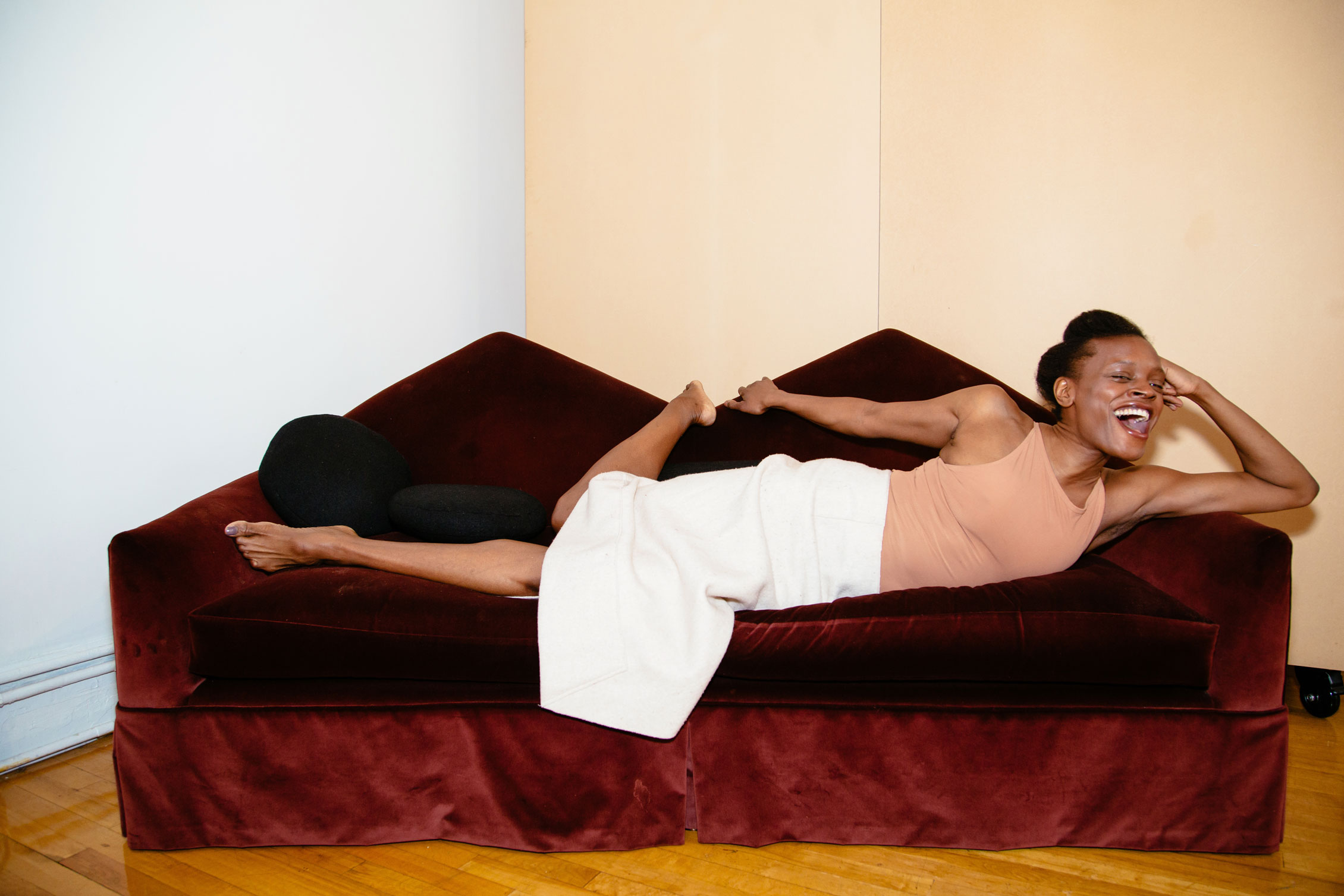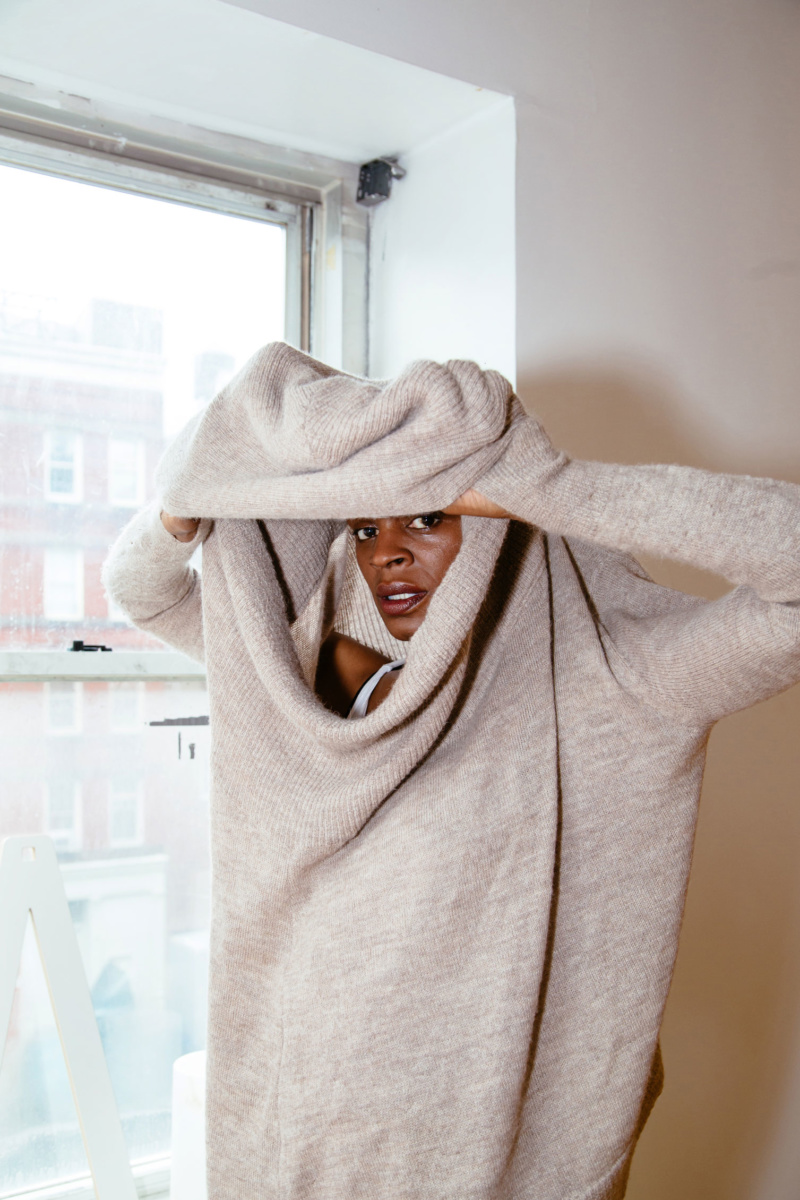
Okwui Okpokwasili has been a wicked daughter; a bedraggled, long-limbed ballerina in love with a race car; the proprietor of a remote saloon; and the devil herself. Her riveting stage presence features in productions by many of the country’s most innovative theater makers (she played the aforementioned roles in Young Jean Lee’s LEAR, Richard Foreman’s Maria del Bosco, Richard Maxwell’s Cowboys and Indians, and Jim Findlay’s Electric Lucifer, respectively). In her long-standing work with the choreographer Ralph Lemon, Okpokwasili has experimented at the limits of the form: Together, their working process has included everything from a 12-hour durational experiment in silence to a performance of extended keening.
Dedicated patrons of New York’s downtown performance scene know that Okpokwasili’s name in a playbill signals a chance to bear witness to the performer as author. Her supreme intelligence is always respectful of the material and yet nonetheless transformative. The recent recipient of a MacArthur Foundation “Genius” grant, Okpokwasili endows each gesture and intonation with multivalent resonance. In the flourished extension of a hand, the lowering of the eyes, or the lifting of the chin, Okpokwasili conjures the ways that past events haunt action in the present tense.

Raised in the Bronx, Okpokwasili is the daughter of Nigerian immigrants. Her own work often takes her autobiography as a prism, refracting it to summon other narratives—deeply rooted, often gnarled, still a site for new life. With great formal inventiveness, her performances plumb histories of colonization and the African diaspora; the ongoing legacies of violence that structure black life in America; and the creativity and power that has endured, even within varying degrees of terrible unfreedom. This spring, her latest work, Adaku’s Revolt, premieres at Abrons Arts Center. In English, “Adaku” translates to “daughter of wealth,” and the performance tells the story of one such girl who resists the standards of beauty imposed on her by others, including the alteration of her hair—its rituals, its searing tools and its loaded semantics. Describing her thinking to me, Okpokwasili speaks in the vocabulary of sense memory: Not only the burn of a hot comb on one’s ear, but also the more chronic fear of freshly-straightened hair getting wet, an unceasing, anxious tensing against the rain.
Adolescence, that quivering precipice churning with hormone and urge and defiance, likewise anchors Okpokwasili’s 2014 performance, Bronx Gothic, an epistolary novel come to life. She reads from furtive exchanges in an extended monologue, which she enunciates in two distinct vocal registers: One a queasy coo of drawn out syllables and vocal fry, the other an emphatic baritone. The two voices, resounding from one body, articulate the conversation between one young girl, untutored, who asks about breasts and semen and orgasms, and another, more knowing, who boasts her sexual knowledge while grappling with its entwinement in trauma. Yet the craft of the work allows the cordon that distinguishes the two girls to slacken, and for this uncertainty to evoke, generatively, all the ways that desire evades certitude. One scene recounts a dream of being on the beach. A haze of partially remembered scents and temperatures, in the associative logic of the unconscious, swiftly morphs memories of pleasure into those of pain. First the sandy idyll is too hot, the ground scalds; then, the ocean’s cool promise of relief betrays, becoming a tidal wave of boiling blood.
The experience of wading into unknowing is, in Bronx Gothic, extended to audiences, who enter a darkened space in which Okpokwasili convulses for a terrifying duration, her back to the audience. For this section of “quake movement,” she whips from skull to sacrum, elbows jabbing outward and head bobbing. Sometimes her hands whirl in a sped-up version of the gesticulations that can accompany fervent language; the audience senses urgency, but not necessarily its cause. In a documentary about the work’s creation by Andrew Rossi, Okpokwasili shares footage of the performance with her parents. We watch them watching her. Her mother immediately has her own lens of interpretation, connecting the movements she sees her daughter enacting to dances “based in the history of the culture.” She then demonstrates her own dancing on the spot, right there in the living room, shedding her crimson suit jacket to better move, to be unencumbered.

For her Poor People’s TV Room (2017), Okpokwasili shares the stage with a multigenerational cast including Thuli Dumakude, Katrina Reid and Nehemoyia Young. The work takes as one starting point the Nigerian Women’s War of 1929, a revolt against British colonizers in Nigeria. Okpokwasili’s husband and frequent collaborator, Peter Born, co-wrote and directed the piece; the sets and lighting of his design offer audiences exercises in skewed perspective. The performers are sometimes partially obscured behind a cloudy plastic scrim, or lying supine on a table, a live feed projecting their images upright to create the illusion of a living room. Choreographic strategies bring the women’s bodies together, then apart. In some moments, one performer might give her weight over to another; in others, she might act as a shadow, moving almost in unison, but not quite. The ensemble also acts as a chorus, with voices swelling in harmonic refrains of “have I swallowed enough?” and “look at this body, boy.” While the work does not recount a straightforward narrative of the historical event, it crafts new possibilities for address out of the etymological resonances of “egwu,” which in the Igbo language connects protest to performance—to dance.
Some of this research similarly informed Sitting on a Man’s Head, which Born and Okpokwasili presented at the 2018 Berlin Biennale. An experiment in “collective utterance,” participants engage in conversation with the performance’s facilitators, and then share in improvising songs of grievance and joy. One anecdote is perhaps exemplary: Born had a fruitful conversation with a father and young son just outside the installation. The boy was eager to experience the work, but did not want to remove his shoes, as was required. Moments later, Okpokwasili spotted the kid, astride her husband, who was crawling on all fours. Desires were permitted and alternatives were sought out. A body’s faculties were put to new use. The child’s feet never touched the ground.










 in your life?
in your life?

